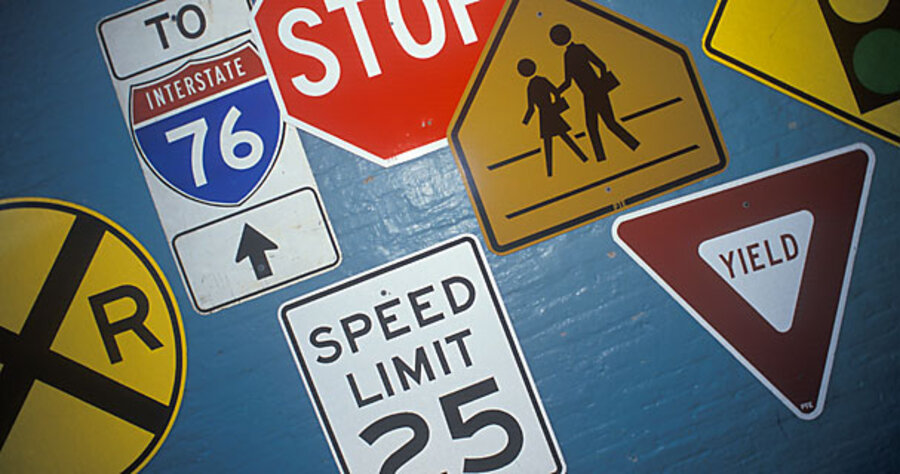Do traffic laws cause accidents?
Loading...
In this month's Atlantic, behavioral psychologist John Staddon puts forth that traffic signs actually make streets more dangerous.
Signs, says Mr. Staddon, condition drivers to be less observant: instead of looking at the situation in front of them, drivers look off to the side of the road, looking for the sign to tell them how to drive. By continuously training drivers to rely on signs instead of their own judgment, traffic authorities are cultivating what psychologists call "inattentional blindness."
Staddon says that Great Britain has a far more sensible approach to traffic control. There are very few mandatory stops in Britain; the stop "signs" are just dashes in the road, and they don't really mean stop, just yield. Instead of four-way stop signs and their Byzantine rules, the Brits frequently use "roundabouts" (translation: traffic circles) whose only rule is to give way to traffic coming from the right (translation: the left). In Britain, speed limits are determined by road type, and are not as seemingly arbitrary as they are in the US.
The result, says Staddon, is safer roads:
Detailed statistics show that as of 2003, fatalities per mile traveled were 36 percent greater in the U.S. than they were in the U.K. Traffic deaths per million people show an even greater disparity through 2006, the most recent year for which full statistics are available. If the U.S. death rate were the same as the U.K.’s, roughly 6,000 fewer Americans would die each year—that’s half again as many Americans as have died in Iraq in the past five years.
So if removing some traffic signs makes the streets a little safer, wouldn't it follow that removing all signs would make it a lot safer?
The available evidence says yes. In the past few years, several European cities have fomented this kind of vehicular anarchy right in their town centers, with positive results.
In 2005, the New York Times described the center of Drachten, a Dutch city of about 50,000, which, at the insistence of traffic guru Hans Monderman, stripped away all regulatory traffic control features:
Not only was it virtually naked, stripped of all lights, signs and road markings, but there was no division between road and sidewalk. It was, basically, a bare brick square.
But in spite of the apparently anarchical layout, the traffic, a steady stream of trucks, cars, buses, motorcycles, bicycles and pedestrians, moved along fluidly and easily, as if directed by an invisible conductor. When Mr. Monderman, a traffic engineer and the intersection's proud designer, deliberately failed to check for oncoming traffic before crossing the street, the drivers slowed for him. No one honked or shouted rude words out of the window.
"Who has the right of way?" he asked rhetorically. "I don't care. People here have to find their own way, negotiate for themselves, use their own brains."
According to a 2006 article Der Speigel, the number of traffic accidents in Drachten "declined dramatically" after the area was redesigned.
"The many rules strip us of the most important thing: the ability to be considerate. We're losing our capacity for socially responsible behavior," Monderman told Der Spiegel. "The greater the number of prescriptions, the more people's sense of personal responsibility dwindles."
Mr. Monderman, who died in January, replicated his success in other cities in Germany, Denmark, and Great Britain.
Aspects of the Monderman Model has been tested in the US as well, in West Palm Beach. A 2004 Wired article describes the city center's transformation:
When the city of 82,000 went ahead with its plan to convert several wide thoroughfares into narrow two-way streets, traffic slowed so much that people felt it was safe to walk there. The increase in pedestrian traffic attracted new shops and apartment buildings. Property values along Clematis Street, one of the town's main drags, have more than doubled since it was reconfigured.
I've long suspected that the reason we Americans tend walk so little is not that we're lazy, but that we don't want to get hit by a car. Too many of us live in places where you can't get to the supermarket without crossing a major roadway. What if, instead of regulating traffic, we simply forced it to share space with pedestrians? The experience of Drachten, West Palm Beach, and other cities suggests that doing so would make our communities more walkable, more vibrant.
Prosperity through anarchy. It's a concept that challenges many of the basic premises of environmentalism. But, as Monderman showed us, sometimes longstanding rules prevent us from seeing what's right in front of us.





